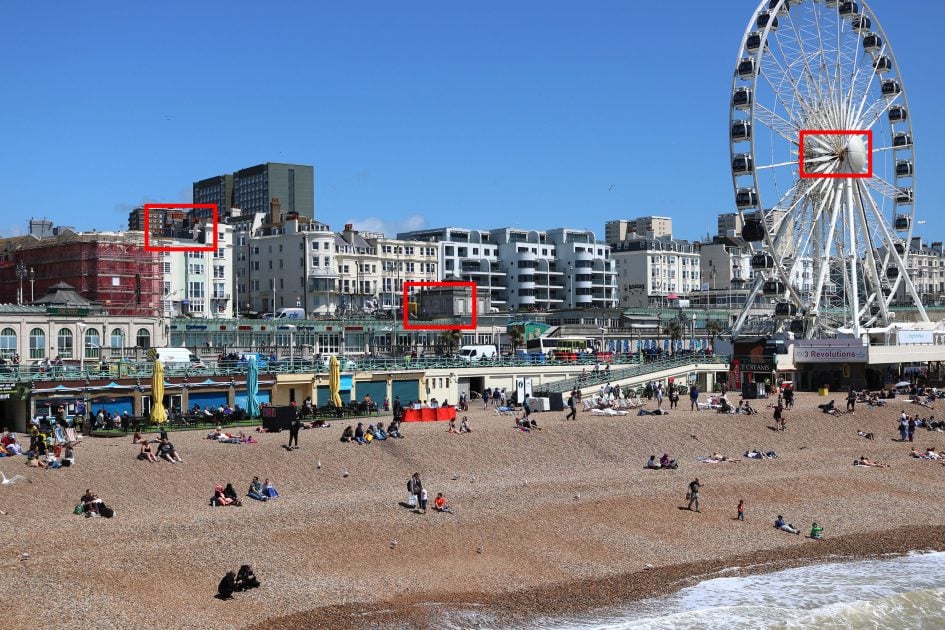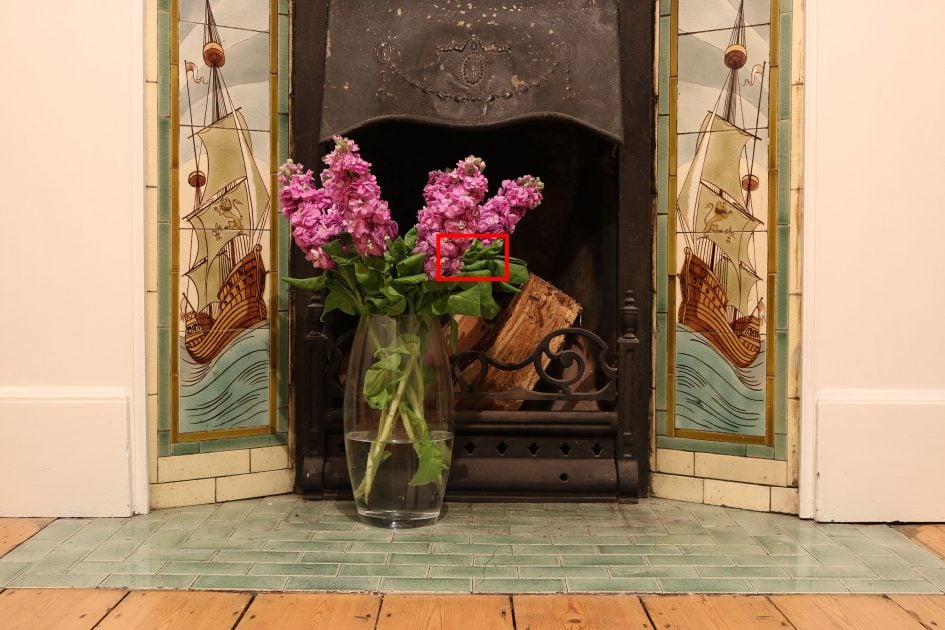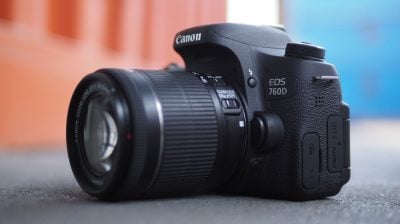Canon EOS Rebel T6s / 760D Review
-
-
Written by Gordon Laing
Quality
To compare real-life performance, I shot the scene below with the Panasonic Lumix G7 and Canon EOS 760D / T6i within a few moments of each other, using their kit zooms and base sensitivities. Note the image quality on the 760D / T6i is identical to the 750D / T6i, so these results equally apply to that model. Both bodies were fitted with their respective kit zooms set to f5.6 in Aperture Priority. The G7 was fitted with the Lumix G 14-42mm f3.5-5.6 and the EOS fitted with the EF-S 18-55mm f3.5-5.6 STM. I’ve matched their vertical field of view here and compared their quality in a 4:3 shape – as such, the Canon is effectively performing as a 21.3 Megapixel camera in this area, but that’s still over 5 Megapixels higher than the Lumix G7.

On this page I’m comparing out-of-camera JPEGs using the default settings. On the next page you’ll find my noise results for both JPEG and RAW files. I’ve taken three sets of crops from each image, indicated by the red rectangles on the image above and presented them below at 100%. The higher resolution of the Canon means its crops show a slightly smaller area. The Canon results are in the left column and the Lumix G7 crops are in the right column.
In terms of real-life detail in the crops below, there’s not a lot between them. Look at the railings, the TV antennas, the various grills and you’ll see there’s no perceptible benefit to the Canon’s extra 5 Megapixels in the same area. Normally at this point I’d point out bigger differences due to the quality of their respective kit zooms, but I’m pleased to report Panasonic and Canon supply both of these bodies with decent lenses. You may however notice Canon’s default JPEG processing applies a little more contrast and smoothing, for a slightly punchier result, albeit one that can look a little smudged at times. It’s easy to turn down when processing RAW files though.
Ultimately the message to take home here is even when fitted with similar quality lenses, there’s little if any extra benefit in real-life resolution to the Canon, despite its higher megapixel count. There are differences between these two cameras which may sway you more towards one than the other, but resolving power shouldn’t be one of them. Scroll down further for a comparison with the Nikon D5500.

Above: Lumix G7 JPEG (left) and Canon EOS 760D / T6s JPEG (right) at 100 ISO

Above: Lumix G7 JPEG (left) and Canon EOS 760D / T6s JPEG (right) at 100 ISO

Above: Lumix G7 JPEG (left) and Canon EOS 760D / T6s JPEG (right) at 100 ISO
Canon EOS 760D / T6s vs Nikon D5500 quality
But what about when the kit lens varies quality? In the second table below, taken on a different day, you’ll see how the EOS 760D / T6s compares against the Nikon D5500. Both have 24 Megapixel APS-C sensors, but as you can see there’s a big difference in the quality of their kit zooms, especially towards the edges. The Nikon kit zoom may be able to collapse to save space when not in use, but it’s simply not as sharp or well-corrected as the Canon STM kit zoom in the corners. The Canon results are in the left column below, and the Nikon D5500 results in the right column.

Above: Canon EOS 760D / T6s JPEG (left) and Nikon D5500 JPEG (right) at 100 ISO

Above: Canon EOS 760D / T6s JPEG (left) and Nikon D5500 JPEG (right) at 100 ISO

Above: Canon EOS 760D / T6s JPEG (left) and Nikon D5500 JPEG (right) at 100 ISO

Above: Canon EOS 760D / T6s JPEG (left) and Nikon D5500 JPEG (right) at 100 ISO

Above: Canon EOS 760D / T6s JPEG (left) and Nikon D5500 JPEG (right) at 100 ISO
Canon EOS 760D / T6s vs Lumix G7 noise
To compare noise levels under real-life conditions, I shot this scene with the Panasonic Lumix G7 and Canon EOS 760D / T6s within a few moments of each other at each of their ISO settings. Both cameras were set to RAW+JPEG and the noise reduction settings to their defaults. Auto contrast adjustments on both were disabled. Both bodies were fitted with their respective kit zooms, adjusted to deliver the same vertical field-of-view; as such the Canon is effectively being compared as a 21.3 Megapixel camera.

I took crops from each ISO setting from each camera and have presented them below at 100%; the cropped area is marked by a red rectangle on the image above. I’m presenting the JPEG results in the first table and a RAW comparison in the second table below it.
Both cameras were set to f5.6 in Aperture Priority mode and metered the same shutter speeds for each ISO value. So what you’re looking at below really is like-for-like and directly comparable.
At first glance of the in-camera JPEGs, the two most obvious differences are the white balance and crop size, the latter being a little tighter on the Canon due to its higher resolution. As with the previous page though, I wouldn’t say the Canon is resolving any finer real-life detail than the G7 here, but what about noise levels? After all, the Canon does have a larger APS-C sensor. The Lumix G7 results are in the left column below and the Canon 760D / T6s results in the right column.

Above: Lumix G7 JPEG (left) and Canon EOS 760D / T6s JPEG (right) at 100 ISO

Above: Lumix G7 JPEG (left) and Canon EOS 760D / T6s JPEG (right) at 200 ISO

Above: Lumix G7 JPEG (left) and Canon EOS 760D / T6s JPEG (right) at 400 ISO

Above: Lumix G7 JPEG (left) and Canon EOS 760D / T6s JPEG (right) at 800 ISO

Above: Lumix G7 JPEG (left) and Canon EOS 760D / T6s JPEG (right) at 1600 ISO

Above: Lumix G7 JPEG (left) and Canon EOS 760D / T6s JPEG (right) at 3200 ISO

Above: Lumix G7 JPEG (left) and Canon EOS 760D / T6s JPEG (right) at 6400 ISO

Above: Lumix G7 JPEG (left) and Canon EOS 760D / T6s JPEG (right) at 12800 ISO

Above: Lumix G7 JPEG (left) and Canon EOS 760D / T6s JPEG (right) at 25600 ISO
Judging from the crops above, the G7 begins to exhibit more visible noise speckles than the Canon from around 800 ISO, although it’s not really obvious until you reach 6400 ISO. But look closely at the Canon and you’ll notice greater smearing in the same range, indicating higher noise reduction. I’ve seen this before from Canon, being more noise-averse for JPEGs using the default settings, and while this avoids speckles on the image, it results in greater smudging.
So what’s going on behind the scenes? Find out in my next set of results, where the RAW files from both cameras have been processed in Adobe Camera RAW, using the same white balance and the same sharpening (50 / 0.5 / 36 / 10), and both with noise reduction set to zero. The absence of noise reduction coupled with strong sharpening means any noise is brought to the forefront, but it allows us to better see what signal each camera has to work with. Again, the Lumix G7 is in the left column and the Canon EOS 760D / T6s in the right column.

Above: Lumix G7 RAW (left) and Canon EOS 760D / T6s RAW (right) at 100 ISO

Above: Lumix G7 RAW (left) and Canon EOS 760D / T6s RAW (right) at 200 ISO

Above: Lumix G7 RAW (left) and Canon EOS 760D / T6s RAW (right) at 400 ISO

Above: Lumix G7 RAW (left) and Canon EOS 760D / T6s RAW (right) at 800 ISO

Above: Lumix G7 RAW (left) and Canon EOS 760D / T6s RAW (right) at 1600 ISO

Above: Lumix G7 RAW (left) and Canon EOS 760D / T6s RAW (right) at 3200 ISO

Above: Lumix G7 RAW (left) and Canon EOS 760D / T6s RAW (right) at 6400 ISO

Above: Lumix G7 RAW (left) and Canon EOS 760D / T6s RAW (right) at 12800 ISO

Above: Lumix G7 RAW (left) and Canon EOS 760D / T6s RAW (right) at 25600 ISO
Looking at the crops above, I think it’s clear how well the Canon RAW files (in the right column) respond to processing, delivering crisper details than the in-camera JPEGs. It’s also revealing how similar the Canon looks to the Lumix with the same processing applied to their RAW files.
I’d also say noise levels are fairly similar up to about 1600 ISO, but what happens next is what’s really interesting. Normally beyond 1600 ISO is where larger sensors begin to take a lead over Micro Four Thirds, but judging from the results below I think the Canon is actually exhibiting fractionally higher noise levels, especially in terms of chroma noise. It’s not a huge difference to be fair, but the important thing is the Canon doesn’t have an advantage in noise levels in this comparison, despite its larger sensor area. I don’t think the Lumix G7 has an improved sensor, but perhaps the new Canon 24 Megapixel APS-C sensor isn’t performing quite as expected, at least in this comparison. Again I wouldn’t worry too much about it, as there are bigger differences in handling and usability to weigh-up, but in terms of real-life resolving power and noise, I’d say both the G7 and EOS 760D / T6s are evenly matched; this also applies to the EOS 750D / T6i as they share the same imaging pipeline.
In my final set of results below I’ve made a RAW comparison between the EOS 760D / T6s and the Nikon D5500, this time with the Canon in the left column and the Nikon in the right.

Above: Canon EOS 760D / T6s RAW (left) and Nikon D5500 RAW (right) at 100 ISO

Above: Canon EOS 760D / T6s RAW (left) and Nikon D5500 RAW (right) at 200 ISO

Above: Canon EOS 760D / T6s RAW (left) and Nikon D5500 RAW (right) at 400 ISO

Above: Canon EOS 760D / T6s RAW (left) and Nikon D5500 RAW (right) at 800 ISO

Above: Canon EOS 760D / T6s RAW (left) and Nikon D5500 RAW (right) at 1600 ISO

Above: Canon EOS 760D / T6s RAW (left) and Nikon D5500 RAW (right) at 3200 ISO

Above: Canon EOS 760D / T6s RAW (left) and Nikon D5500 RAW (right) at 6400 ISO

Above: Canon EOS 760D / T6s RAW (left) and Nikon D5500 RAW (right) at 12800 ISO

Above: Canon EOS 760D / T6s RAW (left) and Nikon D5500 RAW (right) at 25600 ISO
In the crops above the Canon exhibits greater noise artefacts at higher sensitivities than the Nikon, particularly above 3200 ISO, although is looking a little crisper as a result. Again though, any differences are pixel-peeping here and once you’ve applied noise reduction, I’d say there’s little between them.
The important messages to take home from my results pages are that the kit zooms play a big role in ultimate quality and that the smaller Micro Four Thirds sensor in the Lumix G7 can better keep up with the APS-C sensors in both resolution and noise than you might first assume.




